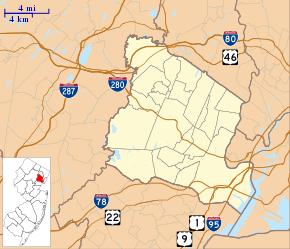Newark Symphony Hall
Newark Symphony Hall is a performing arts center located at 1020 Broad Street in Newark, Essex County, New Jersey. Built in 1925, it was added to the National Register of Historic Places in 1977. It was known for many years as The Mosque Theater, and is the former home of the New Jersey Symphony Orchestra, New Jersey State Opera and the New Jersey Ballet Company.[3]
Salaam Temple | |
Symphony Hall and Boys Chorus School | |
   | |
| Location | 1020 Broad Street, Newark, New Jersey |
|---|---|
| Coordinates | 40°43′40″N 74°10′35″W |
| Area | 1.0566 acres (0.4276 ha) |
| Built | 1925 |
| Architect | Grad Associates |
| Architectural style | Classical Revival |
| NRHP reference No. | 77000867[1] |
| NJRHP No. | [2] |
| Added to NRHP | October 5, 1977 |
The Hall is operated by the non-profit Newark Performing Arts Corporation (NPAC).[4]
Design and construction
Originally built in 1925 by the Shriners at a cost of more than $2 million as Salaam Temple and colloquially known as The Mosque, the four-story building has been Newark Symphony Hall since 1964.[4][5] The interior features Greek and Egyptian motifs, marble columns, a crystal chandelier, gold-leaf fret work and two-columned side promenades. The neo-classical building was designed by Frank Grad,[6] a prominent Newark architect, whose work includes the Lefcourt Newark Building and many others downtown.
The 3,500-seat main concert hall is named for Sarah Vaughan, a native Newarker, and is renowned for its acoustics.[7] Newark Stage is a 200-seat black box theater used by theatrical productions. The Terrace Ballroom is used for receptions. The Studio is a rehearsal space. The Dance Studio is home to one of three facilities in the state used by the school of the Garden State Ballet, founded in 1951.[8]
History
During its early years the theater received the patronage of Mrs. Parker O. Griffith, with a foundation supported by the Griffith Piano Company. [9] The company also built the Griffith Building, used as a showroom, workshop, office tower and recital auditorium.[10][11] In the early 1920s, the company formed a partnership with Earl Beach, the Griffith Beach Organ Company. Beach had worked with Robert Hope-Jones at his factory in Elmira, New York. The organ in Symphony Hall is one of ten theatre organs installed in northeastern New Jersey between 1921 and 1925. The Harmonic Tuba has H.J. (Hope-Jones) stamped on it.
New Jersey's first television station, WATV Channel 13, debuted on May 15, 1948 from studios at The Mosque Theater. The commercial station was owned by Atlantic Television, a subsidiary of Bremer Broadcasting Corporation who also owned WAAT (970 AM, now WNYM) and WAAT-FM (94.7 MHz., now WNSH) whose studios were also in the building. Today Channel 13 is non-commercial WNET. From 1958-1961 the former WATV studios were home to WNTA Channel 13. From 1965-1989, WNJU Channel 47.
In 1964, the floundering Mosque Theater was on the verge on bankruptcy and there was a threat of it being torn down. Sol Hurok, an impresario who had presented many of his artists there commented, "This would be a terrible misfortune for music. It is one of the great concert halls of the country, with marvelous acoustics and great sight lines. It must be preserved." It was purchased by the city for $340,000, becoming a non-profit organization, and renamed Symphony Hall.[5][12][13]
Among the opera companies and stars who have appeared at Symphony Hall are the Metropolitan Opera, Jerome Hines, Beverly Sills, Roberta Peters, Leontyne Price, and Robert Merrill (who made his debut there).
Victor Borge, Judy Garland,[14] Bob Dylan, Patti LaBelle, Teddy Pendergrass, Richard Pryor, James Cleveland, Count Basie, Kirk Franklin, Queen Latifah, Gladys Knight, Parliament-Funkadelic, The Temptations, Tony Bennett and many, many more artists have also performed.[15][16][17] The Rolling Stones and Eric Clapton are among the rock legends to have performed at the venue.[18]
Prior to the opening of the New Jersey Performing Arts Center, Symphony Hall was one of the principal performance venues in the state, one of the homes of the New Jersey Symphony, the Newark Boys Choir, and the New Jersey State Opera.[19] The Newark Dance Theater,[20] African Globe Theater Works, and the New Jersey Ballet also showed work at the Hall. While much activity has shifted to NJPAC, Symphony Hall's continues to present theater, music and dance.[21][22] Community organizations have been conducting their annual programs at Newark Symphony Hall for twenty-five years and more, and continue to do so.
The area just south of Downtown Newark near Lincoln Park is known as The Coast. Newark, and the Coast in particular, in the past has been a large producer of gospel music and continues to produce well-known black artists.
Newark Symphony Hall is home to Special Ensemble,[23] winners of the McDonald's Gospelfest, and hosts the "When Praise Goes Up!" annual gospel showcase. Members of Special Ensemble include Chanel Pearson, Craig McCargo, Kimani Carson, Drew McMillan, Donovan Jones, Gabriel Moses, Robert Johnson, Leah Gaines, Melina Wilson, and Nia Harris. Special Ensemble was founded by Hugh Davis and is under the musical direction of Candice Anderson and the managing direction of Nicole Davis. They have been together since August 2010.
In 2007, an announcement was made for the development Museum of African American Music, a Smithsonian Institution affiliate. The museum would be a collection of archives of "jazz, blues, spirituals, hip-hop, rock 'n'roll, gospel, house music, and rhythm and blues".[15]
In 2009, it was announced a campaign to restore the theater was under way. As of January 2020 the building is being restored to celebrate the 100th anniversary in 2025. Events in the Sarah Vaughan Concert Hall, Newark Stage and Terrace Ballroom continue during restoration.
In 2010 the venue for the first time hosted events of the Geraldine R. Dodge Poetry Festival.[24][25]
In November 2018, NPAC, the Hall's operating company, appointed Taneshia Nash Laird, former Executive Director of the Arts Council of Princeton, as its new President and Chief Executive Officer.[4]
In December 2019, the Hall hosted singing and dancing auditions for a BET miniseries about the history of Uptown Records.[26]
Operation
The Newark Symphony Hall is operated by the non-profit Newark Performing Arts Corporation (NPAC).[4] The Hall's annual budget is $1.7 million, of which the city of Newark contributes $600,000. The Hall is listed on state and national registers of historic places, and pursues state-based historic tax credits and other tax credit streams and initiatives, such as Opportunity Zone funding.[4] NPAC's CEO and President is Taneshia Nash Laird.[3]
See also
References
- "National Register Information System". National Register of Historic Places. National Park Service. March 13, 2009.
- "New Jersey and National Registers of Historic Places – Essex County" (PDF). New Jersey Department of Environmental Protection – Historic Preservation Office. April 1, 2010. p. 5. Archived from the original (PDF) on March 27, 2009. Retrieved August 21, 2010.
- "Jimi Hendrix and Aretha Franklin played here. Now it needs a $40M makeover". NJ.com. March 28, 2019. Retrieved March 12, 2020.
- "Newark Music Hall With Rich History Needs Expensive Makeover". US News. March 20, 2019. Retrieved March 11, 2020.
- "Mosque Theater Names Cultural Executive", The New York Times, July 8, 1964, retrieved March 20, 2011,
Symphony Hall, Inc., a nonprofit cultural group organized yesterday to make Newark's Mosque Theater a center for the performing arts, has named as its ...
- Fahim, Kareem (November 28, 2006). "A Concert Hall Short on Top Acts, but Long on Potential". New York Times. Retrieved September 11, 2010.
- "Griffith Beach organ". Archived from the original on July 24, 2011. Retrieved September 11, 2010.
- Garden State Ballet
- Newark Symphony Hall website
- DePalma, Anthony (June 12, 1983). "OUTSIDER SHOWS FAITH IN NEWARK". NY Times. Retrieved July 22, 2010.
- Sills, JoAnne (November 23, 2008). "Newark's forgotten music center". Newark Star Ledger. Retrieved September 11, 2010.
- "Newark Pledges $340,000 To Arts; Mosque Theater Would Be Transformed into Center", The New York Times, July 12, 1964, retrieved March 20, 2011
- "Sol Hurok Applause from Newark", The New York Times, April 24, 1994, retrieved March 20, 2011
- http://njmonthly.com/articles/lifestyle/people/shore-lore-music-man.html
- Lincoln Park/The Coast
- Old Newark.com Memories of the Mosque
- "The New Look of New Jersey Pop". The New York Times. January 11, 1976.
- "Rolling back the years: a look at the Stones' 1965 Newark concerts". The Sar-Ledger. October 16, 2012. Retrieved December 12, 2012.
- "Nre Jersey State Opera". Archived from the original on April 19, 2010. Retrieved September 9, 2010.
- Gallmans Newark Dance Theater
- http://www.nj.com/newarkguide/index.ssf/2007/09/historic_music_hall_has_bright.html
- http://blog.nj.com/njv_joan_whitlow/2009/05/newarks_past_and_future_are_at.html
- "Newark Symphony Hall Special Ensemble". NSH Special Ensemble. Retrieved October 15, 2012.
- Lee, Felicia R. (October 5, 2010). "Geraldine R. Dodge Poetry Festival Tries Newark". The New York Times.
- http://www.nj.com/news/index.ssf/2010/10/the_sounds_of_poetry_and_stude.html
- "Can you sing like Mary J. Blige? Rap like LL Cool J? N.J. miniseries casting call wants you". NJ.com. December 11, 2019. Retrieved March 12, 2020.